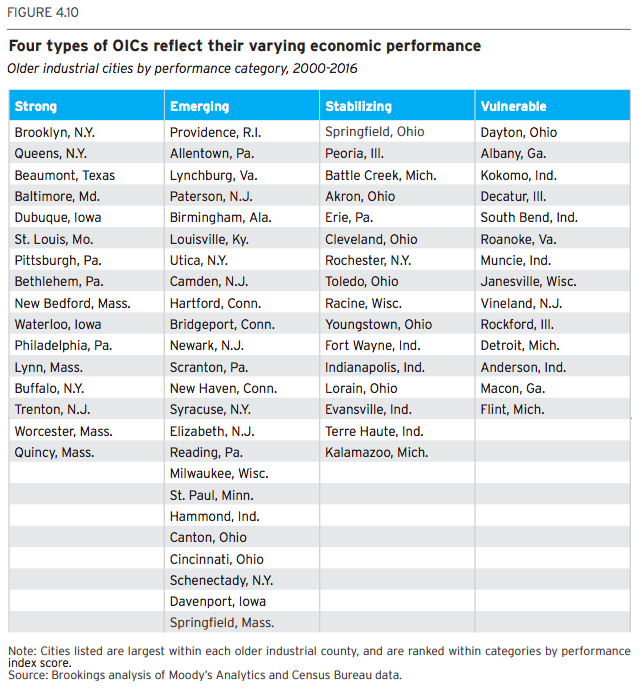Brookings Institute Report: Renewing America’s economic promise through older industrial cities
This report, released in April, delves into the status of cities that prospered during the industrial era, most of which have suffered loss of population and prosperity due to deindustrialization.
Continuing the academic tradition of ignoring the arts and their impact on the economic success of a community, the report however does mention the culture of a community:
“Innumerable factors contribute to the culture of a place, such as where its residents originally came from, what they do for a living, and the characteristics of their surroundings….For as much strength as they draw from their shared culture, however, these cities’ fraught history of management-labor relations and pronounced racial segregation remain aspects of their contemporary societies that they must overcome to secure a better future.”
A deeper dive into the culture of the community, and the degree to which the community succeeded or failed in developing social capital through the arts, would be valuable information. (See Social Impact of the Arts Project, University of Pennsylvania).
The report uses statistics from 365 counties in the United States that had at least one city with a population of 50,000 or larger in 2016. They then identified 185 of those counties in which manufacturing represented at least 20% of all jobs in 1970, an arbitrary date that misses the start of deindustrialization in the late 1950’s.
Through this definition, the study misses a substantial number of communities with 2016 populations of less than 50,000. While Pennsylvania has 56 municipalities classified as cities, all but a few have an industrial heritage. Only ten of those cities had a 2016 population of 50,000 or more, though the number was higher in the peak year 1950, when industry was booming.
The report filters out 70 “older industrial counties” (they deliberately interchange city and county) that transitioned less successfully than other industrial counties from 1970-2016. The basis of the calculation is each county’s employment-by-industry structure as of 1970, and assumes that jobs in each sector grew at the same rated they did nationally in that period. The report seems to not include a variable for the degree to which industry was the major employer, which would seem to disfavor counties that had higher percentages of employment in manufacturing and which completely lost their industries.
While the limited number of cities/counties does not invalidate the study, it does continue to ignore the plight of smaller communities in the Northeast, Midwest and South that continue to seek a solution to their enormous challenges in this post-industrial era.
Bethlehem, PA
In discussing the future of older industrial cities, the report states:
“Bethlehem*, Louisville and Trenton all anchor counties that, if current trends persist, would have relatively small competitive employment deficits (compared to 1970, in fields other than manufacturing) a decade from now.”
Since manufacturing has grown in Bethlehem after the close of Bethlehem Steel, but in areas such as medical devices and plastics, it is difficult to determine whether those statistics were factored into the report’s equation. This report confirms the conclusions in Stronger Than Steel of economic prosperity in Bethlehem and of attracting recent college graduates to live in Bethlehem, Philadelphia and Pittsburgh.
The 70 Older Industrial Counties (OICs) have 11.7% of the US population, 12.2% of the jobs, and produce 12% of the GDP. In Connecticut, these counties contain 75% of the population (the highest percentage), and in Texas they contain 1%. Thirty-four percent of Pennsylvania’s population live in OICs, which produce 36% of the state’s GDP. These numbers would be dramatically different if they included the 35+ counties that contain smaller former industrial cities.
Collectively OIC’s population numbers are stagnant, far below other urban counties, and incomes and employment growth have lagged. People of color have lagged further behind whites in employment and income than they have in healthier urban communities.
“Nearly one in 12 residents in OICs (and one in four poor residents) lived in a neighborhood where the poverty rate exceeded 40%, far higher than in urban counties overall.”
The report concludes by dividing the 70 OIC’s into four categories: Strong, Emerging, Stabilizing, Vulnerable. With the exception of Vineland, NJ, the OICs on the East Coast are rated as either strong or emerging. Most of the communities that are stabilizing or vulnerable are in Michigan, Ohio and Indiana.
The good news for Pennsylvania is that Pittsburgh, Philadelphia and Bethlehem are included in the strong category, with only Erie in the stabilizing category and no cities on the vulnerable list. Again, I wonder what the map would look like if many smaller former industrial cities were included in the study.
Pennsylvania has the third largest rural population in the country, but many of the counties classified as rural are the homes of smaller industrial cities. Like similar areas across the country these communities are facing serious challenges attracting the human and economic capital needed to prosper.
In short, there is hope, but there is also considerable room for innovative new tactics to help older industrial communities to share the prosperity that much of the country is experiencing.
*The report states that Bethlehem’s population is 55,770, when it is actually 75,000. Because the report is based on counties and Bethlehem is in two counties, the report only includes the Northampton County portion of the city, not the Lehigh County portion, which is included in the statistics for neighboring Allentown, throwing both city’s numbers off. The portion of Bethlehem in Lehigh County has few low income census tracts and has higher income, education and employment levels than the portion in Northampton County. It is quite possible that Bethlehem would not even be on this list if the missing third of the city’s population would have been included in the data.





